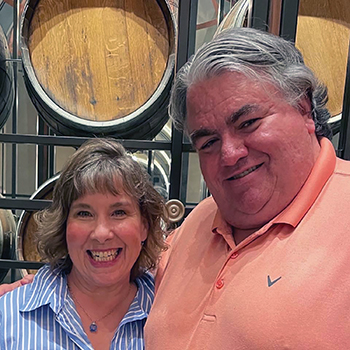Triple-Negative Breast Cancer Survivor
Navigating cancer with faith and support

Just past the 5-year mark from treatment for triple negative breast cancer (TNBC), Lori Beth Miller received a second primary TNBC diagnosis. A strong personality with even stronger faith, she faced both situations head on and continues to help other cancer survivors along the way.
Both of my diagnoses were what I consider circumstantial and easily could have been overlooked. Luckily, mine were not. I share my story to encourage others to listen to their bodies and trust their instincts.
I first noticed something was wrong when my husband, Miller, and I were traveling for a sporting event. The hotel bathroom required that I turn to the right to get into the shower. At home, I turn to the left. Moving in a way that was not the norm enabled me to notice a lump on the outside of my left breast near the armpit.
I was connected with an oncologist who set in motion the beginning of a relationship with a health care team that has been crucial — not just to my treatment but to my life. After saying the awful words, “You have cancer,” the doctor told me a nurse navigator would call within 45 minutes. She not only called, but she also had a plan. She asked me if I was available to come in for something called Super Thursday. Her approach was so warm and comforting. It was so nice that she asked if I was available instead of just talking at me and telling me what I would be doing.
It was easy to see why she called it Super Thursday. It was a very full day. I had an MRI, met with a radiologist, listened to what the tumor board had to say about my specific diagnosis, talked with a geneticist and made plans to get a chemo port. Then Miller and I left for a planned vacation in Florida. When we returned, I learned my diagnosis: Stage II triple negative breast cancer (TNBC). I was 45 years old.
Nothing in the results of my genetic testing showed that I had inherited a gene that predisposed me to breast cancer. Other results showed the recurrence risk was very low. I had a “grab the bull by the horns” attitude and was ready to get rid of the cancer.
My treatment plan included chemotherapy, but before I got started my nurse navigator arranged for us to attend a chemo class at the clinic. I learned what to expect, what to eat, when I would likely lose my hair and more. I was given lemon drops for dry mouth and special mouthwash for mouth sores and so much more, like legacy gift care bags from other survivors.
After chemo, I had a lumpectomy and radiation therapy. Fortunately, by the time I had the lumpectomy, the tumor had shrunk to the size of a pencil eraser. I rang the bell that signaled the end of my treatment after completing radiation.
As I managed neuropathy and hair loss during the five months of treatment, I became very active in the breast cancer community. I started a support group at my church called the Bosom Buddies. I volunteered for Friend for Life (FFL) Cancer Support Network in a peer-to-peer support role. Later, I joined the team as the Assistant Director.
Cancer can give you many “aha” moments, and I had one as a peer navigator with FFL. The idea behind peer support is that you’re matched with someone because of all the things you could have in common, such as diagnosis, treatments and side effects. For some reason, I was matched with a woman who had a different type of cancer but shared the side effect of neuropathy. I soon realized that some connections run much deeper than cancer support. Our cancer relationship turned into a lasting friendship.
A few months after reaching the five-year mark with no recurrence, my underarm on the same side of where I had breast cancer was tender. I gave it a week before contacting my nurse navigator, who brought me in to see my surgeon. Though he couldn’t feel anything during the exam, he took my concern seriously and ordered an ultrasound. The image showed nothing. He recommended coming back in a few months for a re-check.
A few weeks later we were visiting my in-laws for Thanksgiving. Instead of lying on my back in bed like I do at home, I crawled into the bed and laid on my chest. I absolutely felt something. After the holiday, I texted my navigator again and she reminded me that they treat the patient, not the image. This time, an MRI showed a tumor.
Strangely enough, after more tests including a bone scan, we learned it wasn’t a recurrence but a second primary case of TNBC. That just must be the kind of cancer my body makes.
This time, my treatment plan combined chemotherapy with immunotherapy followed by a bilateral mastectomy. Having almost all the same players on my team was comforting. And 10 of them sent me handwritten letters before my treatment began. Today, I am cancer-free.
Along with my health care team and fellow survivors, Miller and my parents provide me with phenomenal support. My parents have devoted their lives to serving others through our faith, and that is why I am so grounded. They have always made me feel I can face anything, and I know I can.


